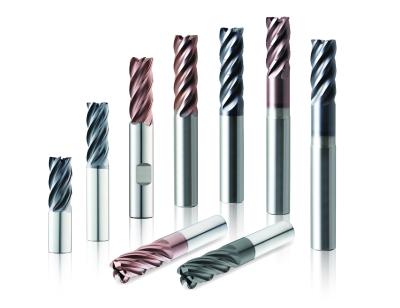Contact Details

To meet customer demands, KYOCERA SGS Precision Tools has expanded the popular Z-Carb HPR high- performance five-flute end mill line with over 900 new tools featuring new long, extended reach, and chip breaker options to combat a wider variety of high metal removal roughing operations.
Utilized extensively in the aerospace, automotive, and general machining industries, SGS’s high performance Z-Carb HPR five-flute roughing end mills are perfect for achieving high material removal rates (MRR) and superior finishes. The specialized five-flute design is engineered to drastically increase productivity 20-40% over conventional three and four-flute end mills. It features variable indexing geometry, which improves chatter suppression over symmetrical designs. The Z-Carb HPR portfolio is equipped with various lengths, reach, square, and corner radius styles, along with new chip breaker options to address different machining situations. These end mills are coated with Ti-NAMITE®-M and Ti-NAMITE®- A, ensuring superior performance even in difficult-to-machine materials like Titanium and Stainless Steel.
Features & Benefits:
-
NEW long, reach, and chip breaker options available!
-
Over 1,700 items in portfolio
-
Full complement of corner radii available
-
Central coolant hole and chip breaker options available on select diameters
-
Plain and Weldon Flat options available for diameters 1⁄2” / 12mm and above
(other retention methods available upon request)
-
1/8" and 6mm cutting diameters and above
-
Special tooling design attributes available upon request
-
Ti-NAMITE®-M coating for higher heat resistance to enhance tool life in Cast
Iron, Steel and with difficult to machine materials like Titanium.
-
Ti-NAMITE®-A coating for superior wear, edge build-up resistance and
extended tool life in high temperature alloys and stainless steel applications.
Series Product Details:
-
Cutting Diameter: 1/8" - 1" / 6,0mm - 25,0mm
-
Length of Cut: 1/4" - 3" / 9,0mm - 75,0mm
-
Overall Length: 1 1/2" - 7" / 54,0mm - 170,0mm
-
Shank Diameter: 1/8" - 1" / 6,0mm - 25,0mm
-
Corner Radius: 0.010" - 0.250" / 0,3mm - 5,0mm
-
Coatings: Ti-NAMITE®-M, Ti-NAMITE®-A
-
Special Options: Internal Coolant, Weldon Flat, Chip Breaker
Material Applications:
-
Steel ≤ 45 HRc
-
Stainless Steel ≤ 45HRc
-
Cast Iron ≤ 45HRc
-
High-Temp Alloys
-
Titanium Alloys ≤ 45 HRc
Industry Applications:
-
Aerospace
-
Medical
-
Power Generation
-
Automotive
-
Mold & Die
-
Casting & Foundries
-
General Engineering
-
Related Glossary Terms
- alloys
alloys
Substances having metallic properties and being composed of two or more chemical elements of which at least one is a metal.
- chatter
chatter
Condition of vibration involving the machine, workpiece and cutting tool. Once this condition arises, it is often self-sustaining until the problem is corrected. Chatter can be identified when lines or grooves appear at regular intervals in the workpiece. These lines or grooves are caused by the teeth of the cutter as they vibrate in and out of the workpiece and their spacing depends on the frequency of vibration.
- coolant
coolant
Fluid that reduces temperature buildup at the tool/workpiece interface during machining. Normally takes the form of a liquid such as soluble or chemical mixtures (semisynthetic, synthetic) but can be pressurized air or other gas. Because of water’s ability to absorb great quantities of heat, it is widely used as a coolant and vehicle for various cutting compounds, with the water-to-compound ratio varying with the machining task. See cutting fluid; semisynthetic cutting fluid; soluble-oil cutting fluid; synthetic cutting fluid.
- die casting
die casting
Casting process wherein molten metal is forced under high pressure into the cavity of a metal mold.
- flat ( screw flat)
flat ( screw flat)
Flat surface machined into the shank of a cutting tool for enhanced holding of the tool.
- milling machine ( mill)
milling machine ( mill)
Runs endmills and arbor-mounted milling cutters. Features include a head with a spindle that drives the cutters; a column, knee and table that provide motion in the three Cartesian axes; and a base that supports the components and houses the cutting-fluid pump and reservoir. The work is mounted on the table and fed into the rotating cutter or endmill to accomplish the milling steps; vertical milling machines also feed endmills into the work by means of a spindle-mounted quill. Models range from small manual machines to big bed-type and duplex mills. All take one of three basic forms: vertical, horizontal or convertible horizontal/vertical. Vertical machines may be knee-type (the table is mounted on a knee that can be elevated) or bed-type (the table is securely supported and only moves horizontally). In general, horizontal machines are bigger and more powerful, while vertical machines are lighter but more versatile and easier to set up and operate.
- shank
shank
Main body of a tool; the portion of a drill or similar end-held tool that fits into a collet, chuck or similar mounting device.





